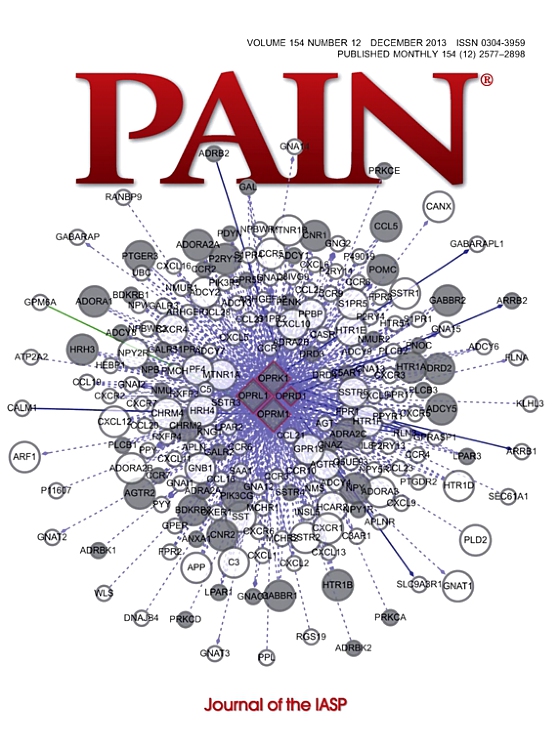420人热感觉的纵向研究。
IF 5.9
1区 医学
Q1 ANESTHESIOLOGY
引用次数: 0
摘要
矛盾热感觉(PHS)是指皮肤变冷时的温暖感觉。矛盾热感觉是一种与神经病变,如糖尿病多发性神经病变(DPN)相关的病理征象。本研究的目的是检查感觉神经系统的特定特征是否与小灵通有关,并评估小灵通是否是热感觉丧失或神经病变的预测因子。利用一项2型糖尿病患者的基线和5年随访数据,我们分析了PHS与感觉和神经生理参数之间的关系,并通过定量感觉测试(QST)、神经传导研究和皮肤活检测量进行了评估。共有420人被纳入研究。62人患有糖尿病但没有DPN, 263人患有DPN,其中89人患有疼痛性DPN, 95人没有糖尿病。基线时,DPN患者发生PHS的频率(51%)高于对照组(32%,P = 0.001, Pearson χ2检验),但合并和不合并DPN的糖尿病患者、疼痛型DPN和无痛型DPN之间无差异(P均≥0.085)。在基线热感觉正常的个体(根据QST标准材料定义)(n = 161)中,基线时的PHS与随访时的热感觉丧失相关(χ2 = 4.7, P = 0.03, logistic回归,联合检验,调整性别、年龄和神经病变状态)。在所有组中,小灵通患者表现出热感觉丧失。这是对小灵通的首次纵向研究。我们证实小灵通与热感觉丧失有关。此外,我们证明PHS是热感觉丧失的早期标志,可能具有治疗或预防意义。本文章由计算机程序翻译,如有差异,请以英文原文为准。
A longitudinal study of paradoxical heat sensation in 420 individuals.
A paradoxical heat sensation (PHS) is the feeling of warmth when the skin is cooled. Paradoxical heat sensation is a pathological sign associated with neuropathy, eg, diabetic polyneuropathy (DPN). The aim of this study was to examine whether specific characteristics in the sensory nervous system are associated with PHS and to evaluate whether PHS is a predictor of thermal sensory loss or neuropathy. Using baseline and 5-year follow-up data from a study on patients with type 2 diabetes, we analyzed the relationship between PHS and sensory and neurophysiological parameters, assessed with quantitative sensory testing (QST), nerve conduction studies, and skin biopsy measures. A total of 420 individuals was included. Sixty-two individuals had diabetes without DPN, 263 had DPN of which 89 had painful DPN, and 95 were controls without diabetes. At baseline, the frequency of PHS was higher in patients with DPN (51%) than in controls (32%, P = 0.001, Pearson χ2 test), but there were no differences between patients with diabetes with and without DPN or between those with painful vs painless DPN (both P ≥ 0.085). Among individuals with normal baseline thermal sensation (defined from the QST normative material) (n = 161), PHS at baseline was associated with thermal sensory loss at follow-up (χ2 = 4.7, P = 0.03, logistic regression, joint test, adjusted for sex, age, and neuropathy status). Across all groups, participants with PHS exhibited thermal sensory loss. This is the first longitudinal study on PHS. We confirmed that PHS is related to thermal sensory loss. Furthermore, we demonstrated that PHS is an early marker of thermal sensory loss, which may have therapeutic or prophylactic implications.
求助全文
通过发布文献求助,成功后即可免费获取论文全文。
去求助
来源期刊

PAIN®
医学-临床神经学
CiteScore
12.50
自引率
8.10%
发文量
242
审稿时长
9 months
期刊介绍:
PAIN® is the official publication of the International Association for the Study of Pain and publishes original research on the nature,mechanisms and treatment of pain.PAIN® provides a forum for the dissemination of research in the basic and clinical sciences of multidisciplinary interest.
 求助内容:
求助内容: 应助结果提醒方式:
应助结果提醒方式:


